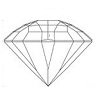5.5: Symmetry
- Page ID
- 3197
Basic
Axes of symmetry
Axes of symmetry have to do with a crystal's balance of shape when rotated around these imaginary axes.
Every crystal belongs to a particular crystal system (cubic, tetragonal, hexagonal, trigonal, orthorhombic, monoclinic or triclinic) and the symmetry for each of these systems is defined by ideal shapes.
Following is an illustration of symmetry axes in the orthorhombic system.
When determining the axes of symmetry, it is important to rotate (or spin) the crystal around that axis through a 360° rotation and judge how many times the exact image is repeated during the rotation.
Figure \(\PageIndex{1}\): The basic form that makes up the orthorhombic system looks like a matchbox.

Figure \(\PageIndex{2}\): Here the match box is represented as 3 pinacoids (3 parallel faces).

Figure \(\PageIndex{3}\): An imaginary needle (axis) is pierced through the center of the top plane.

Figure \(\PageIndex{4}\): We take an arbitrary plane as our starter for the rotation (the front plane in this case).

Figure \(\PageIndex{5}\): During a 360° rotation of the box around the axis, the exact same image is shown twice.

Figure \(\PageIndex{6}\): The same process is repeated but now with the needle (axis) pierced through the side faces.

Figure \(\PageIndex{7}\): We take another arbitrary plane as our starter for rotation (the top plane).

Figure \(\PageIndex{8}\): Again during a 360° rotation of the box around the axis, the exact same image is shown twice.

Figure \(\PageIndex{9}\): The final axis of symmetry (in the orthorhombic box) is through the front plane.

Figure \(\PageIndex{10}\): We now take a pinacoidal face (the front plane) as the start of our rotation.

Figure \(\PageIndex{11}\): And again, during a 360° rotation of the box around the axis, the exact same image is shown twice.

Figure \(\PageIndex{12}\): If one would place the matchbox on a different pinacoidal face, one would get identical results.

As can be seen in the above images, there are 3 axes of symmetry in the orthorhombic system and each axis produces the same image twice during a 360° spin around that axis.
When an axis shows the same image twice, we say it has a 2-fold axis of symmetry (or better: a "digonal axis of symmetry"). So the orthorhombic system is characterized by 3 2-fold axes of symmetry.
Other crystal systems will have fewer or more axes of symmetry. A 3-fold axis of symmetry means that the image is repeated 3 times (named a "trigonal axis of symmetry"), etc.
Planes of symmetry
Planes of symmetry can be regarded as mirror planes. They divide a crystal in two. Each side of the division is the mirror of the other while the total image is not altered by the mirror plane (the symmetry stays intact).
As with the axes of symmetry, the orthorhombic system is used for illustration and there are 3 planes of symmetry in this crystal system.
Figure \(\PageIndex{13}\): First plane of symmetry

Figure \(\PageIndex{14}\): Second plane of symmetry

Figure \(\PageIndex{15}\): Third plane of symmetry

In all the above images, the dividing plane acts as a mirror plane. In other crystal systems, there may be fewer or more planes of symmetry.
Figure \(\PageIndex{15}\): Not a plane of symmetry

To illustrate that not all divisions by a plane create a symmetry plane, the illustration on the above shows a mirror that transforms the crystal into a kite form instead of into its original prismatic shape.
Center of symmetry
Figure \(\PageIndex{16}\): Center of symmetry

A center of symmetry is the central point from which crystal faces and edges appear the same on either end of the center.
In this image, the center of symmetry is where the green, the blue and the red axis of symmetry meet.
The center of symmetry is not always well understood. It is a central point inside the crystal through which faces and edges of one side of the crystal are connected to the other side of the crystal. This results in an "inversion" of the image. The "center of symmetry" is also named an "inversion center".
If you take a single point of a face and draw a line from that point through the center of symmetry, that point will be connected at the other side (but upside down and rotated - inverted). Both distances from the center should be equal.
|
Start out with a matchbox and we draw lines from each corner of the rear plane through the center |
The first corner of the rear plane (lower left) will be connected through the center at the front plane |
We do the same with the lower right corner of the rear plane of the crystal |
|
The upper left corner of the rear face will be connected to the lower right corner of the front plane |
And the upper right corner of the rear plane will become the lower left corner of the front |
The image of the rear face (or plane) is inverted through the center to form the front face |
All the 7 crystal systems will have a center of symmetry for a particular form, yet some forms may not show them. For example, in the trigonal system, the trigonal prism will not have a center of symmetry but the rhombohedron will.
Sources
- Gemmology 3rd edition (2005) - Peter Read








